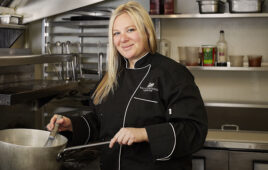
Patrice Hewski, Certified Sommelier, Beverage Manager, Commonwealth National Golf Club & Manor House
Cocktail culture has always been a staple of the bar scene, but in recent years, it’s experienced a complete resurgence with it an increased focus on ingredients, methods and presentation.
This can cause friction, as every bartender has their own way of making certain cocktails, and every member has a certain way they like their cocktails made.
In this article, I’ll explore why this is bound to happen—and how to bridge that gap. In private clubs, it’s important to create a cohesive and creative atmosphere that respects autonomy among staff while creating a baseline to ensure members receive a consistent product.
Cocktail Disconnect
It all comes down to when the bartender or patron came of drinking age, or in the bartender’s case, when they learned to bartend. A lot of factors come into play: What ingredients were available at the time? What did social gatherings look like? What was going on in media?
It might feel like a disconnect when you are experiencing a difference of opinion, but really, it’s just evolution. Cocktails have evolved, and everything that was once popular finds a way of coming back around in some shape or form.
Let’s take a quick look at the generations that frequent the bar scene:
Baby Boomers and Generation X: The ’70s, ’80s and ’90s are three decades that saw a distinct difference in cocktail-making. I’m certain many of our club members frequented bars during this stretch of time. It was a decade of excess, with a focus on speed-bartending, and cocktails during this time were known to be sweet and easy to consume quickly. The focus seemed to be on quantity over quality, so bars invested in shortcuts like sour mix, creams and syrups that were available at the time. Even the classic old fashioned was lost during this era because this wasn’t a generation that typically drank whiskey cocktails that weren’t heavily dosed with sour mix.
Generation Z and Millennials: We are now experiencing a craft cocktail renaissance. Today’s cocktail culture is more focused on quality ingredients, classic recipes and skilled bartending techniques, resulting in a wide variety of well-balanced cocktails. Not only are we getting a run on perfecting classic cocktail recipes, we also have a young generation of bartending innovators who like to experiment with different riffs on classics. They love a crowd-pleasing presentation, as well as experimenting with nontraditional additions like smoke, ice programs, infusions and unique garnishes. You name it, and someone has probably tried it.

Click above for The Mango Schlear recipe, a cocktail named for Commonwealth National Golf Club member Robert Schlear.
Uniting Two Schools of Thought
To unite the generations, focus on what you can do. You can, of course, easily keep your specialty items consistent with training. Still, here will always be arguments about the classics. People will prefer different proportions, garnishes, glassware, sour mix vs. fresh lemon and simple syrup. This is unavoidable.
My suggestion is to first train your staff how to make classic cocktails; you would be doing them a disservice not to. By classic, I mean cocktails that were recorded pre- and during prohibition. However, I wouldn’t hold them to those recipes as the standard.
Say a bartender has a nontraditional way of making a margarita, for example; I’d encourage them to try it out on the membership. There’s no harm in trying something new and different. However, you can’t have complete chaos behind the bar, with every bartender making drinks differently. Think about how disappointing it might be to visit your favorite spot, ask for your regular cocktail, and find that it’s completely different than you expect.
Commonwealth’s Classics
Make sure you have a cocktail menu in place that highlights the specs on the ‘classic call’ drinks and how they are made at your particular club. Add your classics to a menu with your club’s name (i.e. Commonwealth’s Classics) and pick 5-10 frequently ordered classic cocktails to spotlight. The menu will express the way in which the drink is made at your club and if there are any special or nontraditional ingredients used.
For example: Our membership loves Luxardo cherries, so in our club’s old fashioned recipe (pictured right), we decided to pop one in. Historically, an old fashioned doesn’t have any garnish other than a twist, but because the majority prefer it with the cherry, that’s how we prepare it. Now we have a consistent jumping-off point. But if a member reads the ingredients and says, ‘I don’t want a cherry’ or ‘I’d like muddled fruit in my old fashioned,’ then we can easily make it as such.
Another example is that we only add vermouth to a vodka or gin martini if the member requests it. Because this isn’t the norm, it’s important the member know this prior to ordering.
I believe all forms bartending have a place. Let’s agree to disagree about our drink preferences because, in some faction of history, we are all right. What’s most important is creating high-quality drinks that your membership will enjoy.




